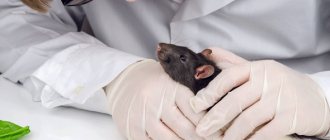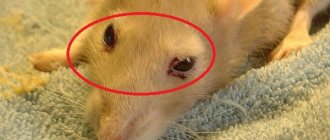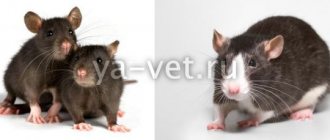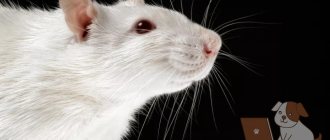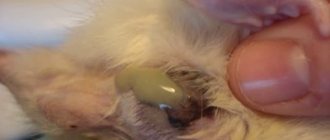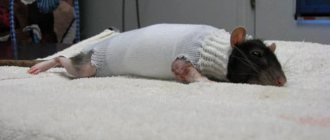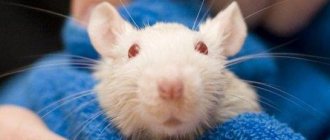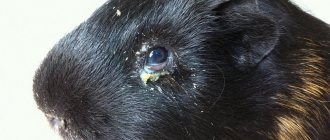What is mycoplasmosis? What kind of illness is this?
Mycoplasmosis in rats is the most common and dangerous disease found in rodents, the consequences of which can be fatal. The main causative agent of mycoplasmosis is the presence in the body of a large number of bacteria Mycoplasma pulmonis. This bacterium is so common that it is difficult to find a decorative rat that is not a carrier of this infection.
The disease most often occurs in adult rats, which have a weakened immune system, living conditions are in poor condition, and the rats are forced to live in poor quality housing. The most common transmission of mycoplasmosis infection in rodents when communicating with each other is by air.
The development of mycoplasmosis can be promoted by:
- weak immunity;
- age-related changes;
- environmental influence.
Mycoplasmosis is a severe infectious lesion of the body; the adaptation period is two weeks, sometimes more than a month. It is advisable to maintain this frequency, since it is impossible to cure the animal in a short time, and the disease becomes chronic.
Can mycoplasma bacteria be transmitted to humans or infect other animals?
The owner of a sick pet should not worry about his own safety - the bacteria that provoke the disease in rats are not dangerous to humans. In total, science knows more than 30 varieties of mycoplasma bacteria, of which 6 species are pathogenic for humans. Rat mycoplasmas are not one of them (unlike mouse mycoplasmas).
A sick rat cannot infect animals of other species either, but it can easily infect its relatives. Therefore, if several rats live in a house and one of them is sick, it should be immediately isolated, otherwise the rest of the rats will also get sick.
Symptoms of the disease in rodents. How to recognize the disease?
Identifying the cause of your kitty rat’s illness is quite simple. According to veterinarians, it is enough to make a high-quality diagnosis, and the causes and symptoms will be clearly identified, which can hardly be confused with the manifestation of other diseases.
This disease can affect both young and old individuals, damaging the upper respiratory tract.
As soon as the body weakens, inflammation develops, which is localized in the upper respiratory tract, gradually the infection descends, turning into bronchitis, the development proceeds rapidly, because Rats' metabolism is very rapid.
Common symptoms of mycoplasmosis in rats are no different from infections that occur in other domestic animals and are manifested by a number of symptoms, such as:
- Rhinitis.
- Uneven (ruffled) breathing.
- Physical weakness.
- Aversion to food.
- Sneezing.
The disease of an infected rodent can progress more and more every day, and if attention is not paid to it in time, it can lead to lung damage.
Diagnosis of mycoplasmosis in rats
It is very important to recognize the disease mycoplasmosis in the initial stages , until the condition of the sick rodent can be monitored and the necessary precautions can be taken.
Therefore, it is worth paying attention to the symptoms of infection as early as possible , prescribing appropriate tests, making an accurate diagnosis and starting immediate treatment.
Clinical signs
The disease itself has pronounced signs and symptoms, so it is impossible to confuse it with anything else. The first days of a sick rat are characterized by frequent wheezing, the animal stops eating, lethargy and apathy are noted, the fur loses its elasticity, it becomes duller and unkempt.
Upon examination, it is revealed that changes appear on the lungs of the decorative rat; blisters and abscesses cover most of the lungs, which leads to the development of pneumonia, as well as disruption of the uterine flora. The eyes and nose begin to secrete fluid in the form of mucus, which confirms the fact that the respiratory system is impaired.
The development of the infectious disease in other animals is very similar in development to the disease in rats. Respiratory problems and poisoning with strong chemicals cause the same symptoms:
- cough and sneezing;
- clogged nasal breathing;
- nose bleed;
- dyspnea.
Before starting treatment for mycoplasmosis in rats, it is advisable to accurately diagnose and identify the exact causes of the disease. If necessary, replace the food, re-lay the bedding, get rid of strong odors (do not use household chemicals, perfumes, deodorants near the cage), if necessary, change the location of the cage. Check the rat for the presence of parasites in the body (lice, fleas).
If, with a sharp change in living conditions, the rat’s protective reaction of the body decreases, stress manifests itself, and its health worsens, you should know that this is not a disease, but a reaction to new living conditions.
Stages of the disease and their brief description
Hidden symptoms of rodent disease are not so noticeable at first, decorative rats behave naturally - they are active, they have an appetite. Although disruption of the mucous membrane, wheezing, and shortness of breath in the lungs are already evident in the body. Coordination is noticeably deteriorated, unnatural postures present a clear picture of the disease. At the initial stage of the disease, rodents behave inactively and there is a loss of appetite. In the thermal stage, the following signs of mycoplasmosis in rats are present: body temperature decreases, slow reactions, lethargy, and apathy are observed.
| Hidden stage | initial stage | Thermal stage |
| No symptoms | Sneezing, nasal discharge | Low temperature, shortness of breath, decreased activity |
Is mycoplasma infection transmitted to humans, can other rodents and animals become infected?
No pathogenic bacteria that can cause this disease in humans have been identified in the body of rodents. Therefore, you should not worry if your pet is sick with mycoplasmosis; such an animal does not pose a danger to humans; mycoplasmosis in rats is not transmitted to humans.
However, as practice and research by scientists show, there are examples of the production of the Mycoplasma pneumoniae strain in mice. Therefore, maintaining personal hygiene during rodent illness will be necessary, and any kind of communication with your pets should be limited.
Diagnostics
The symptoms of mycoplasmosis are similar to those of other diseases, for example, ARVI, allergies, neoplasms in the cerebral cortex. Therefore, only a qualified ratologist should carry out the diagnosis.
First of all, the specialist will ask about the problems of the rodent owner - find out when the pet’s well-being worsened, how the pain is expressed, in what conditions the rat lives, what it eats, etc. The veterinarian will also additionally carry out the following diagnostic measures:
- Examination of the animal is necessary to determine the general well-being of the small patient. The doctor will assess the condition of the skin, mucous membranes, and hair. He will also check for the presence of basic reactions, including unconditioned reflexes.
- Chest X-ray – to assess the condition and performance of the lungs.
- Listening to the work of internal organs , primarily the heart and bronchi. The procedure is carried out using the ear or using a phonendoscope.
- PCR – to accurately identify the causative agent of an infectious disease. The method is 100% accurate. But it has several disadvantages, for example, the duration of the study (2-3 days) and high cost.
The success of treatment depends on a correct diagnosis. Therefore, you should not rely on self-diagnosis in this case. Lost time can cost your pet's life.
Mycoplasmosis in rats: lethality of the disease
An infectious disease such as mycoplasmosis does not always cause problems for rodents. If your pet has high immunity and an active life, he is not in danger. Timely diagnosis and proper treatment will help avoid mycoplasma infection. You need to constantly monitor:
- monitor the vital activity of decorative rats;
- take the right medications on time.
Otherwise, death occurs not from mycoplasmosis, but from repeated infections, important organs of the rat’s body are damaged, treatment does not bring positive results and death occurs.
References
- Clinical recommendations. Urogenital diseases caused by Mycoplasma genitalium. — 2016.
- Federal clinical guidelines for the management of patients with urogenital diseases caused by ureaplasma spp., mycoplasma hominis: Moscow - 2015.
- Non-chlamydial non-specific genital infection. In: Oxford handbook of genitourinary medicine, HIV, and Aids / R. Pattman [et al.] (Eds) ; 1st edition. – USA: Oxford University Press, 2005. – 580 p.
- Gomberg M.A. Treatment of urethritis caused by mycoplasma genitalium / M.A. Gomberg, A.M. Soloviev, I.N. Aniskova // Attending physician. – 2007. – No. 7. – P. 12-15.
- Khryanin A.A. Modern ideas about Mycoplasma genitalium / A.A. Khryanin, O.V. Reshetnikov // Rus. honey. magazine – 2008. – T. 16, No. 19. – P. 1236-1239.
Treatment of mycoplasmosis in rats
It should be understood that treatment of mycoplasmosis at home involves the use of anti-infective drugs.
The use of penicillin antibiotics in the treatment of domestic rodents is strictly prohibited! Since they are not effective in this case, they cause shock and lead to the death of the animal.
An effective treatment for chronic and complicated situations to relieve an attack of suffocation and dilation of the bronchi are herbal decoctions, for example, echinacea - it increases and supports immunity. Oxygen therapy should also be used, which will improve breathing and help remove fluid from the lungs.
As prescribed by the doctor, the course of treatment and the duration of the disease are determined, which is no more than two weeks and depends on the form of the disease.
During secondary infections, antibiotics are most often used, and penicillins are used less frequently. A weak defense reaction in rats results in a severe allergic reaction.
You can carry out therapy yourself. However, do not expect that injecting your rat is easy and simple. It is very important to determine the location of the rodent injection (muscles in the hind limbs). It is important to inject the injection with an insulin syringe so as not to cause damage to the skin.
In cases of pulmonary edema, hormonal therapy is used.
Problem with treating mycoplasmosis in rats
This infectious disease will not bring big problems to decorative rats with high immunity. Knowing that mycoplasma infection has a wide spectrum of damage, it is still treatable if detected at the initial stage.
Caring for a Sick Pet Rat
The treatment procedure for the virus is quite lengthy and promotes a speedy recovery:
- normal room temperature;
- necessarily humidified air;
- the use of fermented milk products to restore microflora;
- increased nutrition with vegetable and fruit purees, syringe feeding if necessary;
- drinking plenty of fluids.
Please note that if you have several pets, you should separate them and keep them in separate cages.
When using a medicinal method of treatment, you should also pay attention to compliance with the rules of hygienic order in the room:
- It is very important to carry out general cleaning of the premises regularly.
- Disinfect the cage in which your pets live.
- Ventilate the room regularly.
- Monitor the temperature in the room.
- It is necessary to constantly remove excrement from a rodent's cage, given that the ammonia released from excrement is harmful to the health of pets, irritates the nasal mucosa and leads to increased discharge, which is not desirable.
Drug treatment of mycoplasmosis in rats
The most effective and efficient way to treat mycoplasmosis in rats is injections.
Despite everything, this is not such a simple procedure, as it requires certain skills and professionalism. It is very important to choose the injection site correctly; in a rat this is the cervical skin fold, and with an intramuscular injection it is the area of the hind limb. It is very important to inject with an insulin syringe and hold the rat tightly while injecting.
How to give medicine to a rat?
Medicines are a very simplified way to treat the infectious disease mycoplasmosis in rats; it is difficult to convince a rat to take medicines, since the medicine has a bitter taste and an unpleasant, repulsive odor. Therefore, the owner should resort to tricks and use a syringe to inject an antibiotic into the corner of the rodent’s mouth. Or dilute the medicine in the rat’s favorite food, for example, vegetable puree.
Dosages of drugs when treating rats differ sharply from dosages when treating other animals (cats and dogs).
Owners should pay special attention to self-medication. Before starting treatment, you must contact a veterinarian and undergo an examination, taking into account the test results and the diagnosis. Failure to take this into account can harm your pet's health.
Treatment should be carried out systematically, in a calm environment, in no case should it irritate or cause anger in the animal, so as not to harm its health or cause stress. Sometimes during treatment procedures it is necessary to restrain the animal in order to avoid dangerous situations both for the owners and for the animal itself, so as not to cause an uncomfortable outcome of the treatment of the beloved pet. Using your experience and knowledge, your actions should be aimed at easy and painless administration of medications, while the baby will be happy and calm.
Clinical signs
The disease can be open and asymptomatic, so that many rats, being infected, but not showing signs of the disease, become carriers. Conventionally, the course of the disease can be divided into 3 periods.
The first is latent, when there are no obvious signs of the disease.
The second is the primary symptoms. The rat begins to sneeze periodically, rhinitis develops, and otitis media may also develop. At the same time, the rat feels quite good. She is active and has no loss of appetite. Treatment provided at this stage is most effective.
The third is late symptoms. The rat begins to develop pneumonia, resulting in severe shortness of breath, sudden attacks of suffocation, the Harderian gland becomes inflamed, as a result of which the eyes become covered with a red crust, rhinitis is accompanied by bloody discharge from the nose, and bloody discharge from the mouth and ears is also possible. The coat becomes yellowish-brown in color, but not always. Alopecia (bald areas) is often found on the fur of animals with mycoplasmosis.
In female rats and mice, micoplasma pulmonis can cause genital mycoplasmosis. It manifests itself in latently ill animals through infertility and abortion. In the open form, inflammation of the female genital tract develops, pyometra may develop, and bloody or purulent discharge comes from the vagina.
Treatment at this stage is very difficult, the prognosis is cautious and even more unfavorable.
Prevention of disease. Caring for a rat after mycoplasmosis
The efforts of rat breeders should be aimed at reducing the possibility of recurrence of the disease in a decorative rat throughout its life. When purchasing your friend, pay attention to the behavior and general condition of the animal. It is very important to purchase a pet from trusted breeders. If you notice obvious changes in the behavior and condition of the animal’s skin, then you should refuse the purchase. Learn more about caring for your rat
Nutrition should be balanced, high-calorie. You must undergo a two-week quarantine if you have several pets of the same species. It is necessary to include products of plant origin in the diet, remove cages on time and carry out preventive measures - all this will contribute to the proper development and health of your pets.
Follow these simple tips to prevent illness or speed up recovery:
- balanced diet;
- monitor the condition of your pets;
- keep your home clean;
- treat illnesses in a timely manner.
Keeping an animal at home requires proper feeding, keeping the cage clean and tidy, without drafts or unpleasant odors.
